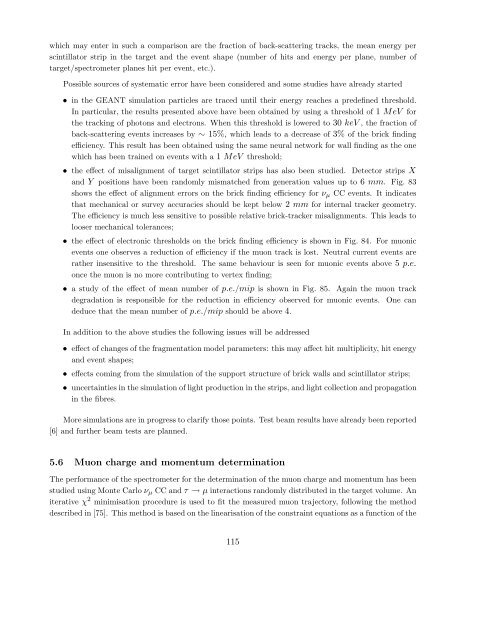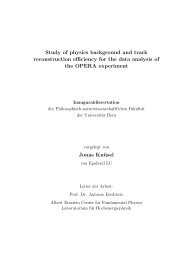Experiment Proposal - opera - Infn
Experiment Proposal - opera - Infn
Experiment Proposal - opera - Infn
You also want an ePaper? Increase the reach of your titles
YUMPU automatically turns print PDFs into web optimized ePapers that Google loves.
which may enter in such a comparison are the fraction of back-scattering tracks, the mean energy per<br />
scintillator strip in the target and the event shape (number of hits and energy per plane, number of<br />
target/spectrometer planes hit per event, etc.).<br />
Possible sources of systematic error have been considered and some studies have already started<br />
• in the GEANT simulation particles are traced until their energy reaches a predefined threshold.<br />
In particular, the results presented above have been obtained by using a threshold of 1 MeV for<br />
the tracking of photons and electrons. When this threshold is lowered to 30 keV , the fraction of<br />
back-scattering events increases by ∼ 15%, which leads to a decrease of 3% of the brick finding<br />
efficiency. This result has been obtained using the same neural network for wall finding as the one<br />
which has been trained on events with a 1 MeV threshold;<br />
• the effect of misalignment of target scintillator strips has also been studied. Detector strips X<br />
and Y positions have been randomly mismatched from generation values up to 6 mm. Fig. 83<br />
shows the effect of alignment errors on the brick finding efficiency for ν µ CC events. It indicates<br />
that mechanical or survey accuracies should be kept below 2 mm for internal tracker geometry.<br />
The efficiency is much less sensitive to possible relative brick-tracker misalignments. This leads to<br />
looser mechanical tolerances;<br />
• the effect of electronic thresholds on the brick finding efficiency is shown in Fig. 84. For muonic<br />
events one observes a reduction of efficiency if the muon track is lost. Neutral current events are<br />
rather insensitive to the threshold. The same behaviour is seen for muonic events above 5 p.e.<br />
once the muon is no more contributing to vertex finding;<br />
• a study of the effect of mean number of p.e./mip is shown in Fig. 85. Again the muon track<br />
degradation is responsible for the reduction in efficiency observed for muonic events. One can<br />
deduce that the mean number of p.e./mip should be above 4.<br />
In addition to the above studies the following issues will be addressed<br />
• effect of changes of the fragmentation model parameters: this may affect hit multiplicity, hit energy<br />
and event shapes;<br />
• effects coming from the simulation of the support structure of brick walls and scintillator strips;<br />
• uncertainties in the simulation of light production in the strips, and light collection and propagation<br />
in the fibres.<br />
More simulations are in progress to clarify those points. Test beam results have already been reported<br />
[6] and further beam tests are planned.<br />
5.6 Muon charge and momentum determination<br />
The performance of the spectrometer for the determination of the muon charge and momentum has been<br />
studied using Monte Carlo ν µ CC and τ → µ interactions randomly distributed in the target volume. An<br />
iterative χ 2 minimisation procedure is used to fit the measured muon trajectory, following the method<br />
described in [75]. This method is based on the linearisation of the constraint equations as a function of the<br />
115




